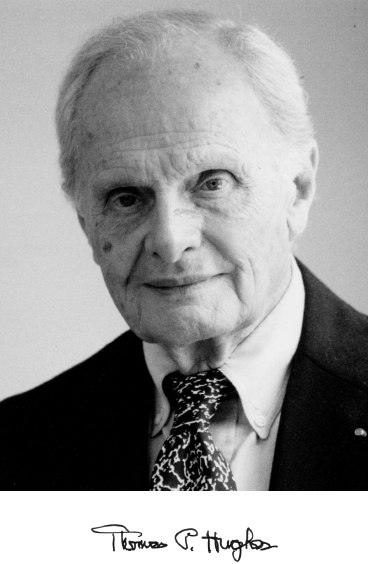1923–2014
Elected in 2003
“For contributions to, and the effective dissemination of, the history of technology.”
BY JOEL MOSES
THOMAS PARKE HUGHES (September 13, 1923–February 3, 2014) was widely regarded as the nation’s preeminent historian of technology. He was 90 years old at the time of his death. He helped found the Society for the History of Technology (SHOT) and received its highest honor, the Leonardo da Vinci Medal, in 1985.
Tom is best known for his analyses of the design, building, and management of large-scale engineering systems, such as electric power networks and the ARPANET/Internet. He wrote, “Technology is messy and complex.… In its variety, it is full of contradictions, laden with human folly, saved by the occasional benign deeds, and rich with unintended consequences” (Human-Built World: How to Think about Technology and Culture; University of Chicago Press, 2004). Tom wanted to distinguish between the drive for simple explanations sought by scientists and the complex reality of many aspects of large-scale engineering systems.
His biography of Elmer Sperry (Elmer Ambrose Sperry: Inventor and Engineer; Johns Hopkins University Press, 1971) won SHOT’s Dexter Prize as the best history of technology book of the year in 1972. Networks of Power: Electrification in Western Society, 1880–1930 (Johns Hopkins University Press, 1983) won the Dexter Prize in 1985. Here Hughes contrasts the
manner in which electric power networks arose in major cities in Britain, Germany, and the US. His emphasis is on differences in which power systems were designed as a result of differences in the social systems in which they were embedded. A major theme in his books was the creative genius, scientific achievements, engineering feats, managerial expertise, and entrepreneurial risks needed in designing and managing large-scale technological systems.
American Genesis: A Century of Invention and Technological Enthusiasm, 1870–1970 (Viking, 1989) was a finalist for the Pulitzer Prize in History in 1990. In it Tom suggested that technology played a greater role in shaping America than political achievement or free enterprise. The American genesis was the creation of the modern technological nation. Rescuing Prometheus (Pantheon, 1998) explored the creation of large technological systems, including SAGE, ARPANET/ Internet, and Boston’s Central Artery/Tunnel. Hughes edited two volumes with his wife, Agatha Hughes: Lewis Mumford: Public Intellectual (Oxford University Press, 1990) and Systems, Experts, and Computers: The Systems Approach in Management and Engineering, World War II and After (MIT Press, 2000).
Tom was born in Richmond, Virginia. After a stint in the Navy during World War II, he received a bachelor’s degree in mechanical engineering in 1947 and a PhD in modern European history in 1953, both from the University of Virginia. His thesis was on the Great Exhibition in London and the Glass Palace, clearly in the history of technology area, but he taught Russian history at Mary Baldwin College. In the following years he increasingly transformed himself from a historian of modern Europe to a historian of technology, the field that he helped create. As can be imagined, academics, especially in the arts and sciences, viewed this new field with suspicion. For more than a decade Tom had short-term appointments at various colleges and universities, including MIT (1963–1965).
In 1966 he was named visiting associate professor at Johns Hopkins University, but he still had not written a significant book. Alfred Chandler, the great business historian, urged him to write one. Tom wrote his biography of Elmer Sperry while
he was at Southern Methodist University in the early 1970s. That book made the cover of Science and led to several tenure offers. In 1973 the University of Pennsylvania appointed Tom to its Department of History and Sociology of Science. At the time of Tom’s appointment the department was itself likely viewed by the faculty of arts and sciences with reservations.
Twenty-five years later the department was arguably a jewel in Penn’s crown, largely due to the luster created by Tom. He served as chairman in 1977–1980. He was appointed Andrew W. Mellon Professor of History and Sociology of Science in 1987 and served until his retirement in 1994 when he became Andrew W. Mellon Professor Emeritus. Thereafter he was also appointed distinguished visiting professor at MIT.
He was elected a fellow of the American Academy of Arts and Sciences, a member of the American Philosophical Society, and a foreign member of the Royal Swedish Academy of Engineering Sciences. Among his many honors, he received an honorary doctorate in engineering from the Royal Institute of Technology in Sweden, and an honorary doctorate in humane letters from Northwestern University.
When Tom was hired by the University of Pennsylvania in 1973, he and Agatha looked for a house in Philadelphia. Tom was surprised that an iconic house by the well-known modern architect, Robert Venturi, was for sale. This was a house that Venturi designed for his mother, Vanna Venturi. It is called “Mother’s House.” Venturi’s wife and partner, Denise Scott Brown, told the Philadelphia Inquirer that, after they bought the house, Tom and Agatha often invited them back to have Thanksgiving dinner in it. Tom, she said, “was a very loving person—he always gave me a kiss, which I called his ‘Southern gentleman’ kiss.”
Tom was indeed a Southern gentleman, with a warm heart and a friendly personality, and he was very supportive to his many friends and students.
Tom’s wife and collaborator, Agatha Hughes, died in 1997. Survivors include their son, Lucian Hughes, daughter, Agatha H. Hughes, four grandchildren, and Tom’s long-time partner, Mary Hill Caperton.





